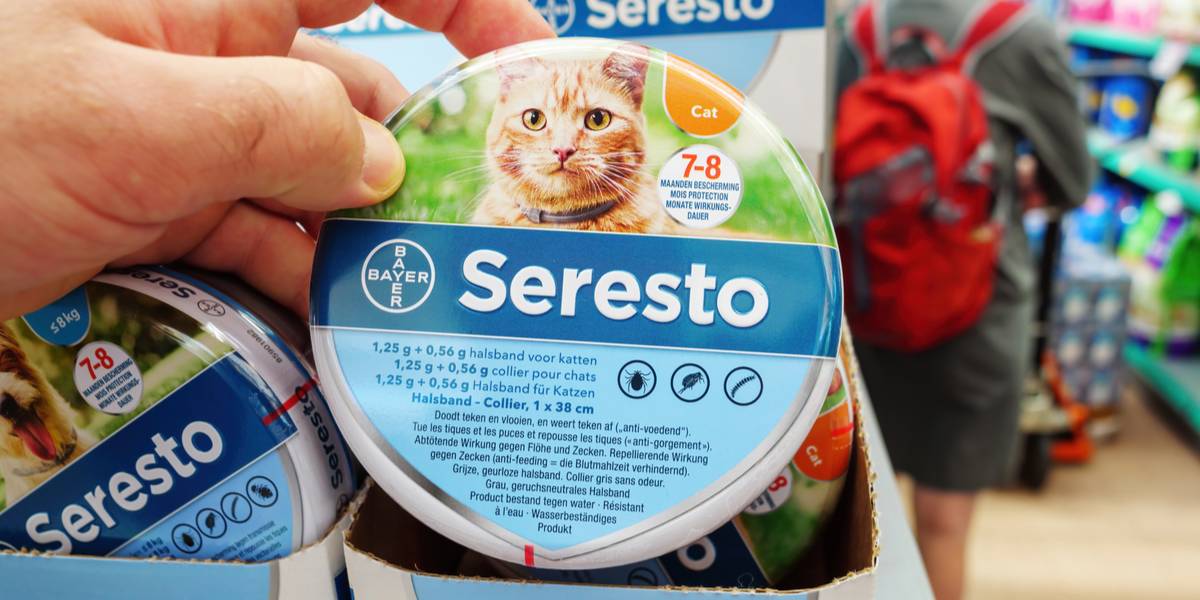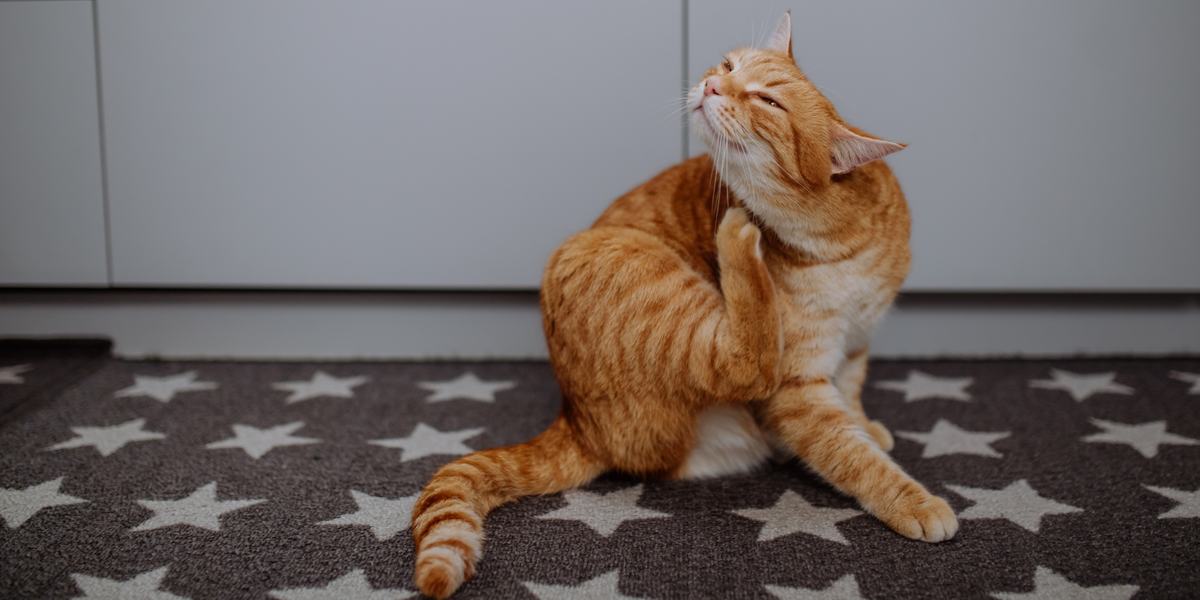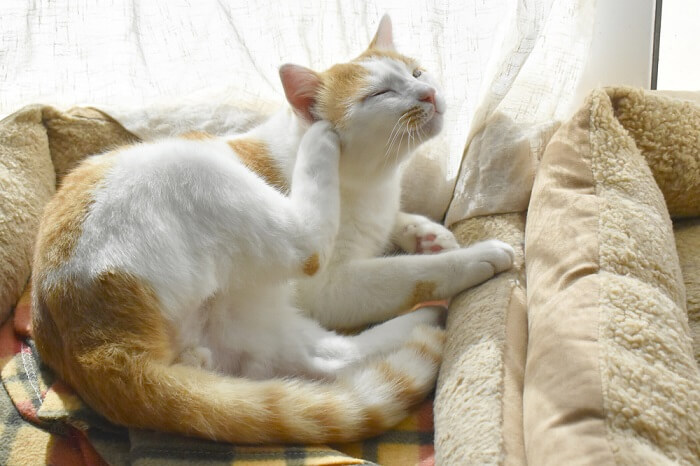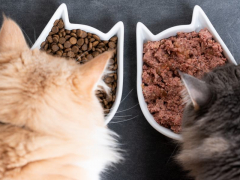
The Seresto collar is a flea and tick collar for cats manufactured by Elanco Animal Health (previously by Bayer Animal Health). In this article, you’ll learn how Seresto works, what parasites Seresto works against, safety concerns and side effects to be aware of, and some frequently asked questions.
Seresto Collar for Cats Overview

About Seresto Collar for Cats

The Seresto collar contains two active ingredients: imidacloprid and flumethrin.
Imidacloprid is an insecticide that acts on the nicotinic acetylcholine receptors of the central nervous system of a flea, leading to central nervous system (CNS) impairment and death. These receptors in insects have a much higher affinity, or desire to bind, to imidacloprid than to similar receptors of vertebrates like cats and dogs.
Imidacloprid is largely effective against adult fleas only. It does not have additional efficacy against fleas eggs and only an indirect effect against larvae, though it can kill adult fleas quickly before they can lay eggs.
Flumethrin is a pyrethroid insecticide that conveys its action through voltage gated sodium channels in nerve tissue. Its action leads to repeated nerve impulses that lead to death of the insect. It also has a very high affinity for invertebrate (insect) nerve tissue, lending to its safety for use in dogs and cats.
As an acaricide, flumethrin is principally effective against ticks. It is able to kill all stages of the tick, including the adult, larva, and nymph forms.
What Does the Seresto Collar Do for Cats?

The Seresto collar repels adult fleas and ticks. It can kill adult fleas within 24 hours after initial application and ticks within 48 hours. According to the manufacturer, Seresto can also impact flea infestations by affecting flea larvae that have come in contact with the collar.
In regard to kill time, there are certainly other topical products that work faster to kill fleas and ticks.
The Seresto collar’s main advantage over many other flea and tick prevention products is that it provides repellency against fleas and ticks while also killing any that come in contact with a cat wearing the collar. Many other common topical and oral flea and tick products do not provide repellency and require the insect to bite the skin in order to die.
Cats with a high sensitivity to flea bites or cats with a flea bite allergy may find more relief with a product that prevents flea bites.
The Seresto collar has a couple of other advantages over other common flea and tick collars. The first is that it claims an efficacy that lasts for eight months, which is longer than any other flea/tick product on the market. The second is that unlike some (much cheaper) flea and tick collars, the Seresto collar more effectively treats the whole cat’s body versus just the areas closest to the collar, providing better flea and tick control.
Seresto achieves this through the drugs being secreted in low doses by way of a special polymer matrix design of the collar. This allows the two active ingredients to be effectively absorbed by the oils of the skin continuously. While some degree of this may remain for a limited time without the collar, removing the collar may not provide the same degree of repellency and treatment and may only extend the collar life by a small comparative amount.
The dog Seresto collar is also indicated for treating and preventing sarcoptic mange. This is a skin condition caused by the mange mite Sarcoptes scabiei, which is in the same family as ticks. Sarcoptic mange is most often transmitted by foxes in the area that carry the parasite.
Sarcoptic mange is rare in cats and uncommon now in dogs because of products like Seresto, Revolution, and drugs of the isoxazoline class. While the Seresto collar does not carry a label for sarcoptic mange in cats, this could be an off-label consideration for outdoor cats especially if foxes are in the area.
Side Effects of Seresto Collar for Cats

The Seresto collar kills adult fleas and ticks for eight months.
It can be common for cats not used to wearing a collar to mildly or occasionally scratch at a collar.
Signs to look for that this is more of a concern include redness or irritation on the skin where the collar is present as well as any signs of hair loss.
The manufacturer indicates that mild reactions like these are possible. In these cases, removal of the collar and washing the area with a non-irritating shampoo (like baby shampoo) or dish soap to remove any residue should be sufficient. However, if signs of redness, irritation, or hair loss persist, the manufacturer recommends pursuing veterinary care.
The Seresto collar is not intended to be chewed on or ingested and should not come in contact with the eyes.
If you are ever concerned that your kitty may have developed side effects while using a Seresto collar, or if an overdose is suspected, make sure to contact your veterinarian, the ASPCA Animal Poison Control Center (1-888-426-4435) or Pet Poison Helpline (1-855-764-7661) immediately for further advice.
Because of the nature for cats to jump onto high, precarious surfaces, like branches, fences, etc., the use of any collar, especially in an outdoor cat, can present a risk for strangulation if the collar catches on something.
The Seresto collar is designed with a quick-release mechanism that allows the weight of the cat to widen the collar, so that the cat will slip out of it. It is always important to realize that such quick-release mechanisms can never have a 100% guarantee and there is always a risk involved using any collar on a kitty.
Seresto Collar for Cats Dosage

Your cat can continue to wear their regular collar as long as the Seresto collar is in contact with the skin.
The Seresto collar is applied for use every eight months and can be used on cats and kittens 10 weeks of age and older.
To properly apply the collar, first remove it from its protective bag and unroll it. The collar will not fit every cat immediately out of the packaging and may require trimming and adjustment.
Place the collar around your cat’s neck, insert the end through the buckle, then tighten it until just two of your fingers can fit comfortably between the collar and your cat’s neck. (This is a good rule of thumb for any kind of encircling, potentially constricting object, like a collar or bandage.)
Pull any excess collar through the loop and trim the collar to leave one inch of overlapping length. The manufacturer indicates that a greater length can be left for growing kittens.
It is always best to frequently assess the status of the collar and readjust anything if needed.
Conclusion

The Seresto collar for cats is a flea and tick collar that carries the main advantages of lasting longer than any other product at eight months, as well as providing repellency against fleas and ticks, which many other topical products cannot do.
Its long-lasting nature does make it a more expensive product up front. While Seresto does have a break-away type of feature in its design, collars should always be used carefully in cats, as they can present a risk of strangulation if the safety feature fails.
The Seresto collar can be a good option for folks who do not want to apply a monthly topical product and in cats where preventing flea and tick bites (i.e., cats with flea bite allergy) is a priority, making the repellency ability of Seresto advantageous.
Frequently Asked Questions
Are Seresto collars safe for cats?
The ingredients in Seresto collars are considered safe to use for most cats. In the cases of both imidacloprid and flumethrin, the receptors in insects have much greater affinity for them than the receptors of vertebrates like dogs and cats. Any cat could develop skin sensitivity to any topical product, so if your kitty has sensitive skin, closely monitor the collar’s location after first putting it on.
The safety of using a collar itself in cats is debated by veterinarians. The Seresto collar does have a break-away type feature in its design to prevent strangulation in the event that the collar catches on something. All the same, there is no 100% guarantee this will always work, and great care should be taken using a collar of any kind on a cat.
Is Seresto a good flea collar for cats?
While some other topical products, like Frontline GOLD for example, have a much faster kill time for fleas, the main benefit of Seresto is that it repels fleas (and ticks), keeping them from biting the skin. Most other topical products do not provide true repellency. Seresto also lasts for eight months, compared to most other products that must be applied monthly.
What are the side effects of Seresto flea collar for cats?
Side effects of any topical product can include hair loss, redness, or irritation at the site of application or where the collar sits on the neck.
The side effect of using any kind of collar if a kitty is not used to one could be some occasional scratching at the collar site. This however should not get worse and should not show any signs of changes to the hair coat or skin.
Is Seresto worth the money?
The Seresto collar for cats is reasonably priced compared to similar products. On average, the Seresto collar that lasts about eight months costs about $60, sometimes less depending on the source. In comparison, an eight-month supply of Frontline Plus costs about $85 to $90. Frontline GOLD costs about $85 for only a six-month supply. Advantage II (which does not treat ticks) costs about $60.
So among similar products, it is not the most expensive, though other products generally have faster kills times for fleas and ticks. But the other products don’t provide repellency and they require monthly application. There are always advantages and disadvantages to making any flea/tick product decision. Make sure to discuss any questions you have with your veterinarian when trying to decide which product may be the best for your kitty.








I bought two Seresto flea collars. I have 2 cats around 3 years old. I put the collars on and ever since my one cat hasn’t done much of anything. He hasn’t got off of the vanity in two days but 2 times, hasn’t hardly eaten or drank much water. Are they allergic to it ? Should I take them off or give it a few more days. I put the collars on August 21st, 2022. Please advise. I don’t want anything happening to them.
Hi Ruth,
The signs you’re describing are not commonly reported effects for Seresto collars, which are more often related to skin irritation. These signs could be a coincidence with the collar being placed around the same time but an uncommon response or reaction to a new product can’t be dismissed either. It would probably be best to remove the collar, at least pending a call to your vet. Not eating, drinking, or moving much is very concerning whether the collar is related to those changes or not. Having your cat examined to make sure something else isn’t causing these issues is important to consider. Calling the manufacturer (currently Elanco) to report these changes and find out if these signs have been reported in other cats can be an important step as well.
My cat looks like she has mange. I had to remove it after 3 months and were still trying to clear up her neck. Very bad for my poor cat.
Thank you for sharing your experience with the Seresto collar, Carol.
Hi Carol, I’m sorry to hear this occurred. Hair loss and skin irritation at the site are possible side effects of the collar in some cats. This does not happen routinely in all kitties, but in those where it is seen, its use should not be continued. It never hurts to report adverse events like these to the company (Elanco). Hopefully, with some help from your vet, the skin lesions will clear up with removal of the collar and some localized therapy.
Much like humans .. cats react differently to the same type of medications
.. I have 2 indoor cats .. put sernesto collar on my female and she would remove it by the time I got home from work .. she also started urinating outside of the litter box .. I had to remove the collar and switch to a topical
The male cat was somewhat used to a collar since I take him outside on a leash.. he adapted very well to the sernesto collar .. he had a minor skin irritation but I removed the collar for the first week and washed around where the collar was and replaced the collar.. did this for three weeks once week and the irritation cleared up
Hi Tony, thanks for sharing. Cats are indeed individuals with unique minds, natures, and tolerances of their own as your story highlights. I’m glad you’ve found a balance that works for them.
I have had great success with Seresto collars in the past. This year, however, I bought new ones for each of my pets (cats and dog) and the fleas have not been affected! I am now seeking a different form of flea treatment. 😞
Have you heard of this happening, perhaps fleas developing a tolerance or a change in the formula?
Thank you for your response,
Erica in Ohio
Hmmm, that’s concerning. I’ve not heard about a growing resistance to the Seresto collar, but it is possible. However, I’m also worried that you may have bought a counterfeit collar. There have been many reports of fake Seresto collars being sold, especially on Amazon. You can learn more about it here.
I buy mine at tractor supply…and I feel it isn’t working like they usually do..help
Hi Dianna, you may need to explain a little more what concerns you’re seeing. Are you seeing fleas or ticks on your cat? Are you seeing other concerns with the collar itself?
I’m not seeing ticks, but fleas,and flea dirt. My cats are indoor / outdoor. ..we’ve seen fleas occasionally on us even.
I remember years ago using another brand, a topical, that stopped working and it was awful..(Frontline 2009)
Hi Dianna,
The Seresto collar is largely only effective against adult fleas. Flea larvae are minimally affected and flea eggs are not. The collar can kill adult fleas before they are able to lay eggs, but if there was a pause or lapse in use of a collar, allowing any eggs or larvae to be introduced by adults before they were killed, the collar will not be able to eliminate those younger stages of the infestation. Now, it’s true that eventually any eggs and/or larvae on a cat and in the environment will develop into adults and the collar will kill them, but this may take some time depending on how many eggs or larvae we’re talking about. An adult flea can lay 50 eggs a day.
Fake/counterfeit Seresto collars have also been documented. Hopefully this wouldn’t be an issue at Tractor Supply, but is worth mentioning.
A research paper from 2020 looking at different flea/tick products for cats did not find any evidence thus far for developing resistance to imidacloprid, the active ingredient for fleas in the Seresto collars.
It is more common for a perceived product failure to be related either to incorrect use of a product or incorrect expectations. But if a product failure is truly suspected, contacting the manufacturer (Merial) may be helpful.
Currently, you may consider using a product that can kill eggs and larvae more effectively. Advantage II for cats and Frontline GOLD would be examples.
How much does a kitten have to weigh to use the seresto collar? My kitten will be 9 weeks old tomorrow and weighs 2.8 pounds.
Hi Laura,
There is no specific minimum weight stipulation provided by Elanco, only that the kitten must be at least 10 weeks old. At a minimum you’d want to wait at least another week before using one. If your kitten is around 3lb at 10 weeks, that is at the upper end of the weight range for that age. Waiting until your kitten is 3lb should be well within the expected safe weight range.
I got the Seresto collar for all my dogs and always stood by the product. I recently became a “cat person” and well, went the Seresto route. My kitten or rather kitty as she’s a year old now, has had an allergic reaction to the collar. Acting on instinct just took a look at the collar as she’s been trying to take it off. She chewed on it and in the past two days has acted a little unusual. After taking a closer look noticed her irritation and hair loss. My wife and I quickly reacted and simply cut off the collar. By no means am I bad mouthing the collar, just thought I’d share my experience and bring it to light for other cat owners.
Hi Cesar,
Thank you for sharing your experience. It’s always helpful to keep in mind that as individuals, any animal could have a adverse response to a new medication even if other pets in the home have not. Hopefully you are able to find another product that will meet your kitty’s needs.